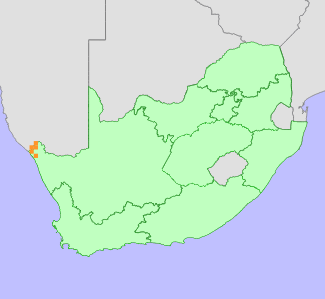|
Scientific Name | Cheiridopsis brownii Schick & Tischer |
Higher Classification | Dicotyledons |
Family | AIZOACEAE |
Synonyms | Cheiridopsis graessneri Schick & Tischer, Cheiridopsis hallii L.Bolus, Cheiridopsis insignis Schwantes, Cheiridopsis pachyphylla Schwantes, Cheiridopsis schlechteri Schwantes (later homonym), not of Tisch. (1928), Cheiridopsis staminodifera L.Bolus, Cheiridopsis turgida L.Bolus |
National Status |
Status and Criteria | Endangered A2ace+4ace; B1ab(ii,iii,v) |
Assessment Date | 2022/06/03 |
Assessor(s) | P.C.V. Van Wyk & D. Raimondo |
Justification | This species has an extent of occurrence (EOO) in South Africa of 817 km², it is known from fewer than five locations and is declining due to overgrazing, habitat loss to mining along the Orange River, and drought related mortality. At least 50% of the population has been lost since 1985 due to the combined impacts of mining and drought, and a further 20% of the population is suspected to be lost by 2030 (generation length 15 years). This taxon also occurs on the Namibian side of the Orange River but its status is not adjusted following IUCN regional assessment procedures due to it also being threatened by mining and climate change there. It therefore qualifies for listing as Endangered under criterion A. |
Distribution |
Endemism | Not endemic to South Africa |
Provincial distribution | Northern Cape |
Range | This species is restricted to southern Sperrgebiet in Namibia to Alexander Bay, Richtersveld. |
Habitat and Ecology |
Major system | Terrestrial |
Major habitats | Richtersveld Sandy Coastal Scorpionstailveld, Southern Richtersveld Scorpionstailveld, Western Gariep Hills Desert, Western Gariep Lowland Desert |
Description | It occurs on dolomite flats. |
Threats |
| The main threat to this species is habitat loss to mining, which is affecting subpopulations in coastal areas near the Orange River in South Africa and Namibia. In addition the South African population is threatened by habitat degradation caused by the overstocking of communal rangelands between 2002 and 2015. Decline due to overgrazing is ongoing since this species is grazed by goats and cannot survive intense grazing pressure. The most severe threat is however drought related mortality, it has lost 40% of its population to the impacts of the worst drought on record that started in 2015 and is still ongoing at the time of assessment. Climate models predict further increases in annual average temperature of between 1.4°C and 2.4°C by 2050 (van Wilgen, 2017). Population decline as a result of drought and heat stress is therefore projected to be ongoing. |
Population |
Not much is known about the subpopulations in Namibia, however in South Africa there has been documented decline of the formerly substantial population that occurred at Baken, approximately half of this subpopulation has been lost to mining and loss will still be ongoing. At least half of this species range within South Africa occurs within areas that have mining rights. The population is also declining throughout its range due to drought.
|
Population trend | Decreasing |
Notes |
| This species has been collected for ex situ conservation in the form of seed vouchers which are stored at the Desert Botanic Gardens at Sendelingsdrif. Genetic material from four separate subpopulations have been collected. |
Assessment History |
Taxon assessed |
Status and Criteria |
Citation/Red List version | | Cheiridopsis brownii Schick & Tischer | EN B1ab(ii,iii,iv,v) | 2015.1 | | Cheiridopsis brownii Schick & Tischer | Least Concern | Raimondo et al. (2009) | |
Bibliography |
Raimondo, D., von Staden, L., Foden, W., Victor, J.E., Helme, N.A., Turner, R.C., Kamundi, D.A. and Manyama, P.A. 2009. Red List of South African Plants. Strelitzia 25. South African National Biodiversity Institute, Pretoria.
Snijman, D.A. 2013. Plants of the Greater Cape Floristic Region 2: The extra Cape flora. Strelitzia 30. South African National Biodiversity Institute, Pretoria.
Van Wilgen, N.J. and Herbst, M. 2017. Taking stock of parks in a changing world: The SANParks Global Environmental Change Assessment. SANParks, Cape Town.
|
Citation |
| Van Wyk, P.C.V. & Raimondo, D. 2022. Cheiridopsis brownii Schick & Tischer. National Assessment: Red List of South African Plants version 2024.1. Accessed on 2025/10/28 |
 Comment on this assessment
Comment on this assessment


